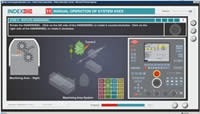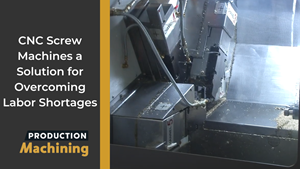Online Training--A Lesson In Reality
As machines become more complex, training becomes an even greater issue. Regardless of what machine features attract a customer, if the operator does not learn how to take advantage of these features, the machine can quickly become a white elephant.
As machines become more complex, training becomes an even greater issue. Regardless of what machine features attract a customer, if the operator does not learn how to take advantage of these features, the machine can quickly become a white elephant.
To help alleviate the calls from customers about machines that “aren’t working properly,” many manufacturers are looking for new ways to provide effective, up-front training. In the highly competitive Swiss market, the situation is no different. Seeing the need to provide better education in the industry, Index Corporation (Noblesville, Indiana) began investigating the route of online training for operators of its Traub line of CNC Swiss turning centers. Much of what it turned up, though, was not satisfying its goal for interactive learning. Slide shows and schematics were not the answer, as they address theory and not real-world examples.
After an extensive search, Index came together with Oxygen Education (Indianapolis, Indiana), developers of simulation-based technical courseware targeted specifically for the manufacturing community. The two organizations have formed an exclusive licensed partnership for Index’s training efforts.
Working with key setup personnel from around the globe, the team assembled an online training tool that can be used to prepare people for Swiss CNC. The software is designed to provide a consistent training message, 24 hours a day, 7 days a week, and the online process eliminates the need for student travel and the associated costs and downtime. The software can be accessed at any Web-connected PC. Even after an operator has completed the course and is working at the machine, he or she can return for a quick refresher or to test certain functions in a learning environment.
Even if operators choose to move on to formal training after completing the course, trainers know exactly where the student stands coming in because of the course’s evaluation methods. Each student comes in acclimated to the machine and on a level playing field.
According to Oxygen Education President Joe Kitterman, his company’s training methodology involves the use of interactive, simulation-based animations that captivate the student and make the learning process more enjoyable, increasing the long-term transfer of knowledge. The training tool for the Traub machines includes exact representations of the machines and controls, giving the students the opportunity to run processes virtually, in a manner that brings situations identical to those they would face on the shop floor.
The entire course is competency-based, so students must complete the chapters in order. Performance is monitored and measured so supervisors can see both progress and performance. Each course is built intentionally in two components. The first half of the course is an overview, including form, fit, function, definition and part identification. The second half is about operation, focusing on the task.
Initially, an overview of the machining center is provided. All graphics are completely accurate—each knob and switch is represented exactly as it appears on the machine. Regardless of where a student is in the course, he or she can experiment with the machine through representations on the screen. A new student begins with an introduction to the high level of the machine’s components. The first chapter becomes a roadmap for the rest of the course. The student opens the lesson and gets a look at the machine, seeing the same screen as it is displayed on the machine when it powers up. All functions of the machine work in the software. Once the student becomes aware of all of the machine’s components and capabilities, he or she progresses to putting the machine to work in true-to-life situations.
At the start of the course, students need very little background on the machines for the training to be effective. Visual representation covers every last detail, all the way to wiping off the barstock. Because Index has been working directly with Oxygen in the development of the training, the machines are shown from the inside out. Complete views are available, without obstructions such as splashing coolant on the glass or closed bar feeder doors. Every detail is covered for a complete, realistic learning experience.
Olaf Tessarzyk, Index Chairman and CEO, says this is something he has been looking for but until now was unable to find. “It fulfills the purpose of providing a better way to introduce our machines and take the fear away from running this equipment. That’s the number one objective of the training,” he says.
Index also sees this training software as a tool for developing interest in the industry for future generations. Mr. Tessarzyk states, “We all have the same problem. Nobody wants to learn how to use screw machines because they think it’s dirty and old. We are trying to bring this software into technical colleges as a next step, so students will see the computer-driven side of the business and get excited about it.” The training program introduces students to the business in a manner that is easy to follow. It’s all visual, with very little reading. Operators can see precisely what is involved in the processes and the exact results of their work.
The tool is currently in the final prototype testing stage for the Traub TNL26 turning center, with release scheduled for early October, 2005. Once the software is live, Index will provide access with the purchase of this machine. Because of its confidence in the effectiveness of this training, Index will continue to expand the availability, developing the software for the entire Traub line. Index takes training seriously, though; it’s not a minor undertaking. Development for the rest of the machines may take a year or more, as every detail is incorporated into the course.
Related Content
Emerging Leader's Problem-Solving Skills Cool Down a Hot Project
This 2023 Emerging Leader developed a product in response to a call for help from Yamaha that was a huge hit in the snowmobile industry when it hit the market in 2010. In fact, it is now a common product that most snowmobile OEMs have implemented.
Read MoreSuccession Planning: Three 15-Minute Activities to Start Preparing for Tomorrow
Succession planning is planning for the future success of your business.
Read More6 Tips for Training on a Swiss-Type Lathe
There are nuances to training a person to effectively operate a Swiss-type lathe. A shop I visited a while back offers some suggestions.
Read MoreVideo Tech Brief: CNC Screw Machines a Solution for Overcoming Labor Shortages
CNC screw machines can exceed job shop productivity and enable manufacturers to overcome perpetual employment gaps.
Read MoreRead Next
Learning Online
Internet-based training provides a new tool for metalworking managers looking to build the technical knowledge of their employees.
Read MoreIncreasing The Value Of Your Most Important Asset
Investing in employee training pays big dividends at this Chicago area screw machine shop.
Read More5 Aspects of PMTS I Appreciate
The three-day edition of the 2025 Precision Machining Technology Show kicks off at the start of April. I’ll be there, and here are some reasons why.
Read More















.jpg;maxWidth=300;quality=90)









